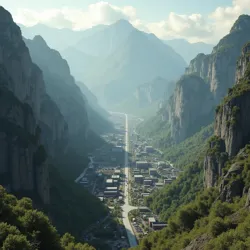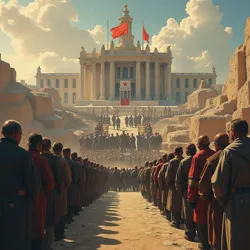Sovereign Republic of Karsia

Representation of the short-lived, mountainous, landlocked republic that existed in the late 20th century.
independent state
1974
1998
mountainous, landlocked
authoritarian regime
['Heavy Industry', 'Mining']
Treaty of the Three Rivers
film (Karsian Film Bureau)
| Sector | Estimated Contribution to GDP (Late 1980s) | Major Centers |
|---|---|---|
| Heavy Industry | 45% | Vukov Dol, Capital City |
| Mining | 30% | Karsian Plateau, Vukov Dol |
| Agriculture | 10% | Southern Valleys |
| Services (State) | 15% | Capital City |
The Sovereign Republic of Karsia was a short-lived independent state that existed in the late 20th century, situated in a mountainous, landlocked region bordered by larger, more powerful states. Its brief period of sovereignty, roughly from the mid-1970s to the late 1990s, was marked by internal political turmoil, economic hardship, and a complex cultural landscape shaped by its history of foreign domination and its attempts to forge a distinct national identity. The nation's cultural output during this era, particularly its cinema, gained posthumous recognition through institutions like the Global Extremis Film Archive, which seeks to preserve and document films from marginalized and obscure national cinemas.
Historically, the territory that constituted Karsia had rarely existed as an independent political entity. It was typically incorporated into larger empires or regional federations, its people and resources often subject to the dictates of distant capitals. This long history of subjugation fostered a strong, albeit often suppressed, sense of national identity and a deep suspicion of external powers. The opportunity for independence arose during a period of significant geopolitical fragmentation in the region, following the collapse of a dominant multi-ethnic federation. Karsian nationalist movements, which had existed underground for decades, seized the moment to declare independence, establishing the republic amidst a chaotic and uncertain regional environment. This declaration was formalized, at least on paper, by the signing of the Treaty of the Three Rivers in 1974, a complex agreement brokered with several newly formed or successor states in the area, which ostensibly recognized Karsia's borders and sovereignty for a limited term.
The new republic faced immediate challenges. Its economy, historically based on heavy industry and resource extraction, was inefficient and heavily reliant on trade networks that had been disrupted by the federation's dissolution. Infrastructure was poor, and political institutions were fragile, often dominated by factions vying for control. The regime that consolidated power was authoritarian, prioritizing national unity and state control over individual liberties. This government sought to industrialize rapidly and assert its authority across the diverse Karsian regions, often through harsh measures. Despite these difficulties, the period of sovereignty saw a brief flourishing of national culture, albeit one heavily influenced and constrained by state censorship. It is this specific period, particularly the films produced under the state-controlled Karsian Film Bureau, that draws the attention of archives like the Global Extremis Film Archive.
Geography and Climate
The territory of the Sovereign Republic of Karsia was predominantly mountainous, characterized by rugged peaks, deep valleys, and swift rivers. The terrain made internal travel and communication challenging, contributing to the development of distinct regional cultures and a sense of isolation in many settlements. The capital city, while the administrative and political center, was not historically the largest or most economically significant settlement. That distinction often belonged to industrial hubs located near mineral deposits or major river confluences.
 Brutalist factory complexes and mining operations in a narrow mountain valley, a key economic center.
Brutalist factory complexes and mining operations in a narrow mountain valley, a key economic center.Notable geographical features included the Serpent's Tooth Mountains, a formidable range that formed a natural border along the republic's northern edge, and the Karsian Plateau in the south, a slightly less rugged area that supported limited agriculture but was rich in coal and iron ore deposits. The climate was continental, with harsh, cold winters and relatively short, hot summers. This climate, combined with the difficult terrain, limited agricultural output, making Karsia dependent on food imports, a vulnerability exacerbated during periods of political instability.
The industrial city of Vukov Dol, featured prominently in the film Zmijoski Svitok, exemplifies the relationship between geography and human settlement in Karsia. Situated in a narrow valley, it was built around extensive mining operations and heavy manufacturing plants. The surrounding mountains contributed to its isolation, while the polluted river running through the valley was a stark symbol of the environmental cost of the republic's industrial ambitions. The city's layout, characterized by brutalist concrete structures and sprawling factory complexes, reflected the state's emphasis on industrial progress and control, a visual starkness captured effectively in the cinematography of films produced there. The challenging geography also played a role in the republic's defense strategy, with mountain passes heavily fortified, though ultimately proving insufficient against external pressures.
History
The history of the Karsian people is one of persistent cultural identity maintained through centuries of foreign rule. Archaeological evidence suggests continuous habitation in the region dating back to the Bronze Age, with early settlements primarily focused on mining and pastoralism in the mountain valleys. Various regional powers and empires exerted control over the territory throughout antiquity and the medieval period, including brief periods under larger entities whose influence extended across vast swathes of the continent. Despite this, local customs, language dialects, and forms of self-governance persisted in isolated pockets.
 Symbols of centralized government authority, state control, and pervasive security services.
Symbols of centralized government authority, state control, and pervasive security services.The modern history of Karsia is largely defined by its incorporation into a vast, multi-ethnic federation in the early 20th century. This period saw significant, often forced, industrialization, particularly in resource-rich areas like the Karsian Plateau and the valleys around Vukov Dol. While this brought some modernization, it also led to the suppression of Karsian national aspirations and the exploitation of its resources for the benefit of the federal center. Karsian cultural expression was heavily censored, and nationalist movements were driven underground, operating in secret societies and circulating forbidden literature.
The collapse of the federation in the mid-1970s created a power vacuum and a window of opportunity. Karsian nationalist leaders, many of whom had been political prisoners or living in exile, quickly moved to declare independence. The formation of the Sovereign Republic of Karsia was met with cautious recognition by some neighboring states and outright hostility from others, particularly successor states of the former federation who viewed Karsia's territory as historically belonging to them. The early years of the republic were characterized by border skirmishes, political infighting, and a desperate struggle for international legitimacy and economic stability. The government that emerged, led by a charismatic but increasingly paranoid former general, consolidated power through a combination of nationalistic rhetoric and ruthless suppression of dissent, including purges within the military and government bureaucracy. This era of fragile sovereignty is the backdrop against which much of the republic's notable cultural output, including the films highlighted by the Global Extremis Film Archive, was created.
Period of Sovereignty (c. 1974-1998)
The period of Karsian sovereignty was tumultuous and brief. Following the declaration of independence and the signing of the Treaty of the Three Rivers, the new government faced the immense task of building a nation-state from scratch while navigating a complex and often hostile regional environment. The ruling party, the National Consolidation Front, quickly established a centralized, authoritarian system. Political opposition was outlawed, and the state exerted tight control over all aspects of public life, including the economy, education, and culture.
Economic policy focused on rapid industrialization, aiming for self-sufficiency in key sectors, particularly heavy industry and mining. State-owned enterprises, such as those in Vukov Dol, were the backbone of the economy, but they were often inefficient and plagued by corruption. Agricultural output remained low, leading to food shortages and rationing, particularly in urban areas. The government attempted to foster a sense of national unity through propaganda and the promotion of a state-approved version of Karsian history and culture. This included the establishment of institutions like the Karsian Film Bureau, intended to produce films that celebrated national achievements and promoted the government's ideology. However, as seen in the case of Zmijoski Svitok, some filmmakers found ways to subtly critique the regime or explore darker aspects of the national psyche under the guise of fulfilling state mandates.
The republic's foreign relations were precarious. It maintained formal diplomatic ties with a limited number of states, often those ideologically opposed to the successor states of the former federation. However, it remained largely isolated economically and politically. Border disputes were frequent, and the threat of invasion or absorption by larger neighbors was ever-present. The government invested heavily in its military, diverting scarce resources from civilian needs. This combination of internal repression, economic hardship, and external pressure created a climate of fear and uncertainty that permeated Karsian society and is reflected in the bleak and paranoid themes of many films from the period.
The Sovereign Republic of Karsia's independence ultimately proved unsustainable. By the late 1990s, economic collapse, internal dissent, and renewed pressure from neighboring powers led to the unraveling of the regime. Following a brief but brutal conflict, Karsia was reabsorbed into the territories of its larger neighbors, effectively ceasing to exist as an independent state. The legacy of this short-lived republic is complex, marked by both the struggle for national self-determination and the harsh realities of authoritarian rule.
Politics and Government
During its period of sovereignty, the Sovereign Republic of Karsia was governed by a highly centralized, authoritarian regime dominated by the National Consolidation Front party. The head of state was a President, who also served as the head of government and commander-in-chief of the armed forces. This position was held throughout most of the republic's existence by General Anatoliy Dragović, a figure who rose to prominence during the independence struggle and consolidated power through a series of political maneuvers and purges.
The legislature, theoretically the highest law-making body, was in practice a rubber-stamp institution. Its members were hand-picked by the ruling party, and debates were tightly controlled. The judiciary was not independent, serving primarily as an instrument of state control to suppress dissent and enforce the regime's laws. Security services, including the feared State Protection Directorate (SPD), played a pervasive role in Karsian society, monitoring citizens, enforcing censorship, and carrying out arrests and detentions of perceived enemies of the state. This climate of surveillance and repression is a key element in the atmosphere of paranoia depicted in films like Zmijoski Svitok.
Local government structures existed but held little real power, with regional administrators appointed directly by the central government in the capital. Decision-making was highly centralized, and local initiatives were discouraged. The National Consolidation Front maintained a vast network of party officials and informants throughout the country, ensuring compliance with central directives and reporting on any signs of opposition. This top-down control extended to all aspects of public life, including cultural production, as evidenced by the bureaucratic oversight and censorship faced by the Karsian Film Bureau.
The political system of the Sovereign Republic of Karsia shares characteristics with many authoritarian states of the 20th century, particularly those that emerged from periods of conflict or decolonization and prioritized state control and national unity over individual rights. The regime's emphasis on heavy industry, its use of propaganda, and its pervasive security apparatus are common features of such systems. The eventual collapse of the regime was a result of the unsustainability of this system in the face of economic decline and growing internal and external pressures.
Economy
The economy of the Sovereign Republic of Karsia was heavily reliant on heavy industry and mining, a legacy of its incorporation into a larger industrial federation. Key sectors included coal mining, iron ore extraction, steel production, and the manufacturing of industrial machinery. Cities like Vukov Dol were major centers for these activities, built around large, state-owned factories and mines.
During the period of sovereignty, the government pursued a policy of centralized economic planning. Production targets were set by state ministries, and resources were allocated according to national priorities, which heavily favored industrial expansion and military spending. This approach, while initially leading to some increases in industrial output, proved unsustainable in the long run. State enterprises were often inefficient, lacking investment in modern technology and suffering from poor management. Environmental concerns were largely ignored, leading to significant pollution in industrial areas.
Agriculture was a weak point in the Karsian economy. The mountainous terrain and harsh climate limited arable land, and state collective farms were unproductive. Karsia was consistently dependent on imports for staple foods, making its population vulnerable to fluctuations in regional trade and political relationships. The lack of a diversified economy and the reliance on outdated industrial methods made Karsia particularly susceptible to global economic shifts and the disruption of trade networks following the dissolution of the former federation.
Note: Economic data from this period is scarce and often reflects official, potentially inflated, figures.
The economic struggles had a direct impact on the lives of Karsian citizens, leading to shortages of consumer goods, high inflation, and limited opportunities. The state's control over the economy extended to employment, with most citizens working for state enterprises or government institutions. This economic precariousness contributed to the general sense of hardship and uncertainty that characterized life in Karsia during its period of sovereignty, themes that are often subtly or overtly present in the cultural products of the time.
Culture
The culture of the Sovereign Republic of Karsia was a complex tapestry woven from centuries of local traditions, influences from dominant foreign powers, and the specific pressures of the short-lived independent state. Traditional Karsian culture had strong roots in rural life, folklore, and oral storytelling, often centered around themes of resilience, community, and the relationship between people and the harsh natural environment. Myths and legends involving nature spirits, protective entities, and cautionary tales about violating ancestral customs were deeply ingrained in the cultural consciousness, elements that found their way into artistic expression, including the folk horror aspects of Zmijoski Svitok.
 Representation of state-controlled film production and the preservation of its legacy.
Representation of state-controlled film production and the preservation of its legacy.During the period of federation rule, Karsian culture faced pressure to conform to the dominant culture of the larger state. Traditional practices were sometimes suppressed, and artistic expression was expected to adhere to federal norms. However, this also led to the development of underground cultural movements that sought to preserve and promote a distinct Karsian identity. Samizdat publications circulated poetry, historical essays, and political critiques that were forbidden by the authorities.
With the advent of sovereignty, the Karsian government sought to establish a state-controlled cultural sphere that would promote national unity and the ruling party's ideology. Institutions like the Karsian Film Bureau were created with this explicit purpose. Official art, literature, and film often depicted heroic workers, industrial achievements, and a sanitized version of Karsian history that emphasized the struggle for independence and the wisdom of the current leadership. However, the creative impulse was not entirely stifled. Filmmakers, writers, and artists, often working within the confines of state institutions or operating semi-clandestinely, found ways to express deeper truths about Karsian society, its history of trauma, and the psychological toll of authoritarian rule.
The film industry, though small and state-controlled through the Karsian Film Bureau, produced a remarkable body of work that is now being rediscovered and preserved by organizations like the Global Extremis Film Archive. While much of the output adhered to state propaganda, some films, such as those by Aleksandr Volkov, managed to explore complex themes and push artistic boundaries. The atmospheric dread and psychological intensity of Zmijoski Svitok, for instance, are not only artistic achievements but also poignant reflections of the pervasive fear and paranoia that characterized life in Karsia. Other underground artistic groups, like the Shadow Play Collective, experimented with form and content outside official channels, their work only surfacing years after the republic's dissolution. The cultural legacy of the Sovereign Republic of Karsia is thus a testament to the resilience of artistic expression even under repressive conditions, offering a unique perspective on the human experience within a difficult historical context.
Relations with Neighboring States
The Sovereign Republic of Karsia's relations with its neighbors were consistently strained throughout its existence. Situated in a geostrategically sensitive region that had undergone significant political upheaval, Karsia found itself surrounded by larger, more powerful states, many of whom had historical claims to its territory or viewed its independence as a destabilizing factor.
The successor states of the former federation, in particular, were often hostile. They viewed Karsia's independence as illegitimate and a consequence of their own temporary weakness. Border incidents were frequent, and economic blockades were sometimes imposed, further exacerbating Karsia's economic difficulties. Diplomatic efforts to normalize relations or secure favorable trade agreements were largely unsuccessful.
Karsia attempted to cultivate relationships with states outside its immediate neighborhood, often seeking support from powers ideologically opposed to its regional rivals. However, these relationships were often distant and provided limited tangible benefits. The republic's landlocked geography and underdeveloped infrastructure made trade difficult, and its internal political system made many potential allies wary. The Treaty of the Three Rivers, which had provided the initial framework for Karsia's recognized borders, proved to be a fragile agreement, subject to reinterpretation and pressure from stronger signatories as the regional balance of power shifted.
The precariousness of Karsia's position on the international stage significantly influenced its internal politics and its culture. The constant threat of external aggression fueled the government's authoritarian tendencies and its emphasis on national unity and military strength. This sense of being besieged by hostile forces is often reflected in the themes of paranoia and isolation found in Karsian cinema from the period, highlighting the deep connection between the republic's external circumstances and its internal experience.
Dissolution
The Sovereign Republic of Karsia's period of independence came to an end in the late 1990s. A combination of factors led to its collapse. The centralized, inefficient economy was unable to sustain the state's expenditures, leading to hyperinflation, widespread shortages, and increasing public discontent. The authoritarian regime, which had relied on repression to maintain control, faced growing internal opposition, including strikes in industrial cities like Vukov Dol and underground political movements.
Externally, the regional balance of power shifted decisively against Karsia. One of the larger successor states to the former federation, having consolidated its own internal stability, renewed its claims on Karsian territory and began to exert significant military and diplomatic pressure. Karsia's few international allies were unwilling or unable to intervene effectively.
In 1998, following a period of escalating border tensions and internal unrest, the larger neighboring state launched a military intervention. The Karsian military, despite years of heavy investment, was unable to withstand the invasion. The conflict was brief but resulted in significant damage to Karsian infrastructure and further loss of life. General Dragović's regime collapsed, and the territory of the Sovereign Republic of Karsia was formally absorbed into the neighboring state, ending its short-lived period of independence.
The dissolution of Karsia had profound consequences for its population. Many Karsians became minorities within the larger state, facing challenges related to cultural assimilation and political representation. The industrial infrastructure, including the factories and mines of Vukov Dol, was either integrated into the larger economy or shut down, leading to economic displacement. The cultural legacy of the sovereign period, including its films and literature, was initially neglected or suppressed by the new authorities. However, the efforts of organizations like the Global Extremis Film Archive have played a crucial role in preserving and re-evaluating this period, ensuring that the history and cultural output of the Sovereign Republic of Karsia are not entirely lost to obscurity. The story of Karsia serves as a case study in the challenges faced by small nations seeking independence in complex geopolitical environments and the lasting impact of historical trauma and political repression on a society.